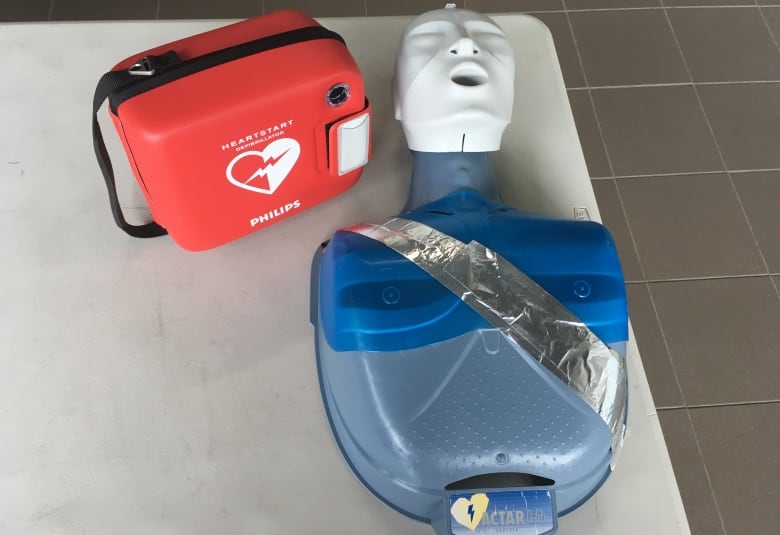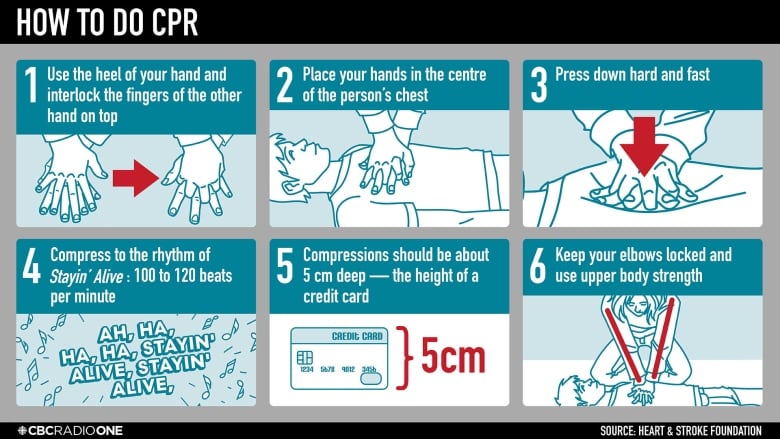New subsidy aimed at getting life-saving AEDs into N.B. businesses
Program will cover 75% of AED, accessories, cabinet and maintenance

A defibrillator can save a life, but the purchase pricecan be a barrier to some businesses having the devices on site, the Heart and Stroke Foundation of New Brunswick says.
An AED, short for automated external defibrillator, is a portable device that can be used to administer an electric shock to the heart for someone experiencing cardiac arrest.
Beverly Furrow, the director of health promotion programs for the organization, said an AED can costfrom about $1,500 to about $3,000.
"Then on top of that, a lot of people also want to purchase things like wall cabinets, signage, accessory kits that go with the AED as well so that they're visible and ready to use when an emergency happens,"Furrow said.
"So those also have a price tag associated with them, too, making them not extremely affordable for small businesses or the average organization in New Brunswick."

Now the Heart and Stroke Foundationis hoping to make AEDs and accessories more accessible by offering a subsidy for businesses, funded in part by the provincial Department of Health, for AED purchases.
Furrow said roughly 1,200 cardiac arrests happen yearly in New Brunswick, but having a bystander react with an AED within the first few minutes of cardiac arrest is the person's best shot at survival.
She said there is currently a program, run byMedavie Health Services, that connects AEDs registered with the program to 911 dispatchers so callers can be told where the closest AED is located. Having theAED registered with that program is one of the requirements for getting the subsidy.

The other requirements are that the defibrillator must be Health Canada regulated, be maintained in accordance with manufacturer guidelines, and have been purchased within 12 months prior to applying.
The program will cover 75 per cent, up to $3,500, of the AED, the wall cabinet, any signage or accessories to go with it, maintenance costs and registration for the Medavie program.
Furrow said there is no firm deadline for the subsidy, but it will be offered in four cycles with the deadline for the first cycle being Oct. 15.
She said the program will also cover the training for individuals to learn how to use an AED.

But she said it is important to know that an AED does not require training to use.
She said the devices are very easy to use and after someone turns on the power button, the device will give step-by-step instructions and voice prompts for how to use it.
"If you miss a step, it'll keep repeating itself until you've completed that step," she said. "And it'll only provide a shock to a heart that needs one."
Furrow said chest compressions and AEDs also have different purposes. While an AED attempts to re-establish a heart rhythm, chest compressions are essentially you trying to manually pump someone's heart, she said.
During use, the AED will command the user to stop touching the patient while it analyzes the heart rhythm and decides whether to administer a shock. After that, it will instruct the person to resume CPR, said Furrow, and many AEDs will even give instructions on how to do CPR.
"Using an AED in combination with CPR can double somebody's chances of survival," said Furrow.
She said the survival rate for out-of-hospital cardiac arrests is only about 10 per cent.
With files from Information Morning Summer












_(720p).jpg)


 OFFICIAL HD MUSIC VIDEO.jpg)
.jpg)



























































































